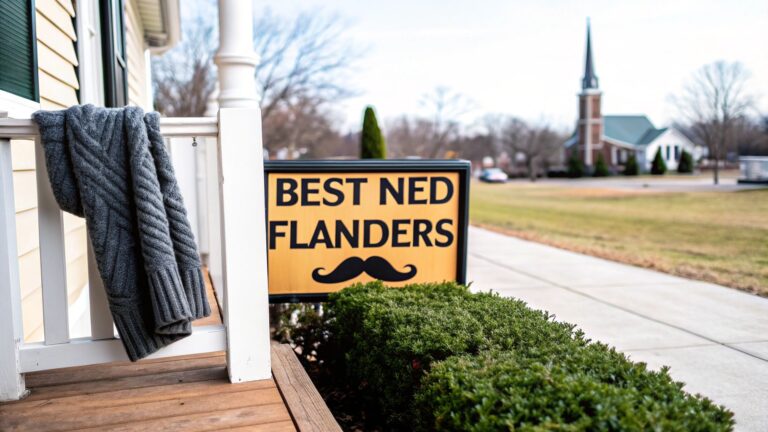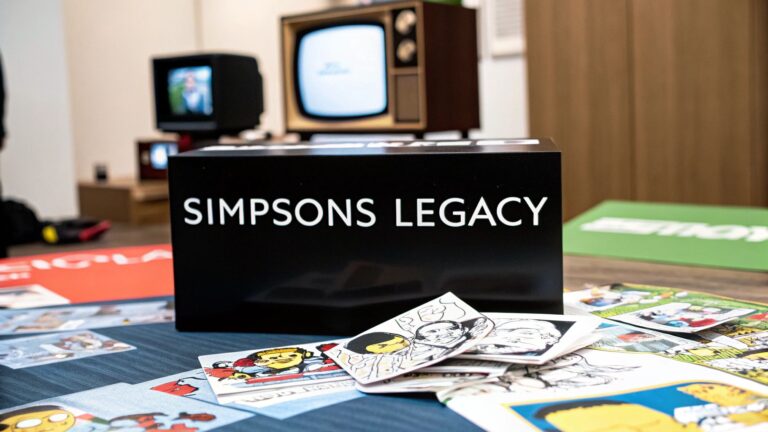For over 30 years, The Simpsons has been more than just a cartoon. It’s a TV legend that has shaped comedy as we know it. With hundreds of episodes, picking the very best is tough. But what makes a good episode great? This list is your guide to the best of the best from Springfield’s golden age, celebrating the moments that made the show famous.
We’re breaking down the episodes that had the perfect mix of smart jokes, funny lines, and a surprising amount of heart. It’s a closer look at the great writing, voice acting, and animation that made these stories last. You’ll remember why “Marge vs. the Monorail” is a comedy classic and why “Homer’s Enemy” is still a dark, brilliant piece of TV.
This article gives you a clear, ranked list of the episodes that are still amazing today. We’ll look at the famous gags, clever jokes about society, and big character moments that make these the best Simpsons episodes of all time. Get ready to revisit Springfield’s greatest hits and see why they’re still number one.
1. Marge vs. the Monorail (Season 4, Episode 12)
The episode “Marge vs. the Monorail” is almost always the first one mentioned. This episode is a comedy masterpiece, packing in tons of jokes, a catchy song, and a great guest star in just 22 minutes. The story follows a smooth salesman named Lyle Lanley, who talks Springfield into spending $3 million on his badly built monorail.

The episode, written by a young Conan O’Brien, is famous for its fast pace and non-stop jokes. From the opening spoof of The Flintstones to Homer’s terrible run as the monorail driver, every scene is a classic. Its success comes from sharp writing and the famous Simpsons art style that made the show’s golden age so great.
Why It’s a Masterpiece
The brilliance is in its perfect story and unforgettable moments. “The Monorail Song,” a parody of a song from The Music Man, is legendary. It shows off the comedy genius of the late Phil Hartman as Lyle Lanley. Guest star Leonard Nimoy also adds a layer of weird humor with his strange appearance.
Standout Moments
- The Monorail Song: A perfectly done musical number that is both funny and really catchy.
- Homer’s Anchor: Homer’s quick-thinking anchor (a giant “M” from a hill) is a classic example of his simple but somehow effective problem-solving.
- Solar Eclipse: A perfectly timed solar eclipse becomes the strange cause of the monorail’s disaster.
This episode isn’t just funny, it’s a perfectly made piece of television that comedy writers still study today for its timing and structure.
2. Homer’s Enemy (Season 8, Episode 23)
“Homer’s Enemy” is a famous, and sometimes controversial, choice for any list for Simspons episodes. It turns the show’s whole idea upside down by introducing Frank Grimes, a hardworking man who is driven crazy by Homer’s easy success and lack of punishment. The episode is a dark, funny look at what happens when a “real” person enters the cartoon world of Springfield.

Written by John Swartzwelder, this episode is very different from the show’s usual style. It compares the logic of reality to the craziness of Homer’s life. Grimes, or “Grimey” as Homer calls him, is like a viewer who can’t believe what’s happening. His sad breakdown is a brilliant joke about society that has pushed other cartoons to explore darker, more complicated ideas.
Why It’s a Masterpiece
The genius of “Homer’s Enemy” is that it’s brave enough to question its own rules. It’s a comment on sitcoms themselves, where flawed characters get rewarded every week. Hank Azaria’s performance as the more and more unhinged Frank Grimes is amazing. He perfectly captures his anger as he realizes no one else sees Homer’s total incompetence as a problem. The episode’s dark ending is both shocking and unforgettable.
Standout Moments
- “I’m Homer Simpson”: Grimes’ final, deadly meltdown where he mocks Homer’s lifestyle by “acting” like him is a chilling and famous scene.
- The Nuclear Plant Contest: Homer wins a kids’ design contest for a new power plant, a win that pushes Grimes over the edge.
- The Funeral: Homer sleeps through Grimes’ funeral, snoring loudly and telling Marge to “change the channel,” which makes the episode’s dark and funny final point.
This episode is a brave, unforgettable piece of TV that proves The Simpsons could be as smart and daring as it was funny.
3. Last Exit to Springfield (Season 4, Episode 17)
Often called the single greatest episode by hardcore fans and critics, “Last Exit to Springfield” is a huge achievement in TV comedy. When Mr. Burns takes away the power plant’s dental plan, Homer accidentally becomes the new union leader to fight for it. He mainly does this so he won’t have to pay for Lisa’s expensive new braces.

The episode perfectly mixes a sweet family story with smart jokes about labor unions, greedy companies, and healthcare. Written by Jay Kogen and Wallace Wolodarsky, its huge number of jokes and clever pop culture references is legendary. The episode is so respected for its commentary that it’s sometimes used in college classes to explain labor unions. This shows how smart the writing was, which is as good as some of the show’s surprisingly real Simpsons predictions.
Why It’s a Masterpiece
Its genius is in how it balances smart jokes with silly physical comedy. The episode makes fun of everything from classic labor movies like On the Waterfront to the Beatles and even Dr. Seuss’s How the Grinch Stole Christmas! Homer’s journey from accidental leader to a hero for the working class is both hilarious and surprisingly touching. It makes the complex topic of union talks easy to understand and super entertaining.
Standout Moments
- Lisa Needs Braces / Dental Plan: The back-and-forth chant is one of the show’s most quotable and famous gags.
- Homer’s Brain: The voice inside Homer’s brain (“If I don’t see you, you don’t see me”) trying to talk him out of leading is pure comedy gold.
- The Infinite Monkey Theorem: Mr. Burns’s room of a thousand monkeys at a thousand typewriters perfectly shows his huge and ridiculous wealth.
This episode is a powerhouse of satire, proving that a cartoon could deal with serious issues with more smarts and humor than most live-action shows.
4. 22 Short Films About Springfield (Season 7, Episode 21)
“22 Short Films About Springfield” is a groundbreaking episode and a strong choice for the best episodes because of its unique, experimental style. Instead of one main story, the episode shows a series of connected short stories about the lives of Springfield’s other characters. This format, inspired by movies like Pulp Fiction, let the show build its world in a way no other episode had before.

The episode is a creative gem, giving beloved side characters like Principal Skinner, Apu, and Chief Wiggum their own mini-stories. Each part has its own style of humor, from slapstick to witty chats, but they all fit together perfectly. This creative style has been talked about in film classes and inspired similar episodes in many other cartoons.
Why It’s a Masterpiece
Its genius is in its big idea and perfect execution. The episode proves that Springfield is a rich, living world where even the smallest character has a story worth telling. It breaks the usual sitcom format while staying very funny and connected. This is a sign of how strong the show’s writing team was, led by Richard Appel and David S. Cohen.
Standout Moments
- Steamed Hams: The part with Principal Skinner and Superintendent Chalmers has become a huge internet meme. It’s a perfect little comedy sketch about a lunch gone wrong.
- Pulp Fiction Parody: The scene with Chief Wiggum and Snake Jailbird is a direct and funny tribute to a famous scene from Quentin Tarantino’s movie.
- Apu’s Wild Party: Apu leaves the Kwik-E-Mart for five minutes to go to a party at his brother-in-law’s house, showing a frantic, fast-paced comedy style.
This episode is more than just a bunch of skits, it’s a celebration of the show’s whole cast of characters. It proves that the heart of Springfield is much bigger than just the Simpson family.
5. You Only Move Twice (Season 8, Episode 2)
This is mostly because of one of the most memorable guest characters in TV history. In the episode, the Simpson family moves to the perfect town of Cypress Creek after Homer gets a dream job at Globex Corporation. His new boss, Hank Scorpio, is incredibly friendly, supportive, and also a James Bond-style supervillain trying to take over the world.
This brilliant idea, from the mind of legendary writer John Swartzwelder, lets the episode be both a sharp parody of spy movies and a relatable story about family sacrifice. While Homer loves his new role, the rest of the family is miserable. This forces him to choose between his perfect job and their happiness.
Why It’s a Masterpiece
The episode’s genius is the character of Hank Scorpio, voiced by the iconic Albert Brooks. Brooks’s mostly improvised performance created a villain who is charming and genuinely likable, even as he threatens the United Nations. This twist on the typical villain, along with a perfectly paced story, makes the episode a standout. It perfectly balances Homer’s work jokes with funny spy-movie gags.
Standout Moments
- Hank Scorpio’s Introduction: Scorpio’s first meeting with Homer, where he casually asks about hammocks, sets the tone for their weird and funny relationship.
- “You want some cream?”: While on the phone with Homer, Scorpio calmly takes out a bad guy with a flamethrower before politely offering him cream for his coffee.
- The Sugar Scene: Homer tackles a “Mr. Bont” to get a packet of sugar for Scorpio, a perfect parody of a classic James Bond fight.
- The Denver Broncos: As a thank you gift, Scorpio gives Homer the Denver Broncos, making his lifelong dream of owning a football team come true.
This episode is a masterclass in mixing a big-idea parody with heartfelt character moments, earning its permanent spot among the greatest episodes ever made.
6. Cape Feare (Season 5, Episode 2)
It’s loved for its perfect mix of suspense and slapstick comedy. In this episode, Sideshow Bob is released from prison with one goal: to kill Bart Simpson. The family is forced into witness protection and moves to Terror Lake, but Bob relentlessly chases them in a brilliant parody of the 1962 and 1991 movies of the same name.
Written by Jon Vitti, “Cape Feare” is a masterclass in parody. It carefully copies shots and ideas from classic thrillers while adding the show’s signature humor. Kelsey Grammer’s dramatic, scary performance as Sideshow Bob makes the character more than just a simple villain. He becomes one of the series’ most loved and famous bad guys. The episode is often used in film studies to show how to do parody well.
Why It’s a Masterpiece
The genius of “Cape Feare” is how it keeps you on the edge of your seat while also delivering some of the most memorable jokes in the show’s history. The pacing is perfect, building from Bob’s scary letters written in blood to the final showdown on a houseboat. It proves that The Simpsons could perfectly pull off a single, focused story parody from start to finish.
Standout Moments
- The Rake Scene: A long scene where Sideshow Bob repeatedly steps on rakes is a legendary piece of physical comedy. It’s a perfect example of a joke getting funnier the longer it goes on.
- Homer’s New Identity: Homer’s complete failure to understand witness protection, introducing himself as “Homer Thompson,” provides non-stop laughs.
- HMS Pinafore: Bob’s plan is ruined when Bart asks him to sing the entire score of the opera H.M.S. Pinafore as a last request. It’s a wonderfully silly and dramatic ending.
This episode shows the show’s amazing creative peak in the early ’90s, with sharp writing, brilliant voice acting, and pitch-perfect parody.
7. Homer at the Bat (Season 3, Episode 17)
This episode brilliantly combines the show’s signature humor with a real love for baseball. The result is a story that both sports fans and comedy lovers can enjoy. Mr. Burns, obsessed with winning a million-dollar bet, fills the power plant’s softball team with nine MLB superstars. This upsets the original team members like Homer.
Written by the legendary John Swartzwelder, the episode is a masterclass in character-driven comedy. Each of the nine guest stars gets a moment to shine, and their strange misfortunes perfectly make fun of their public images. It’s an unforgettable mix of sports nostalgia and classic Simpsons wackiness. This perfect formula makes it a timeless fan favorite and a great source of inspiration for unique Simpsons-themed gifts.
Why It’s a Masterpiece
The genius of “Homer at the Bat” is how it manages so many guest stars without losing its focus on the main characters. The episode perfectly captures the feeling of being an everyday person overshadowed by superstars, only to get a chance at glory through a series of unbelievable events. The end-credits song, “Talkin’ Softball,” is a famous and catchy parody that cements the episode’s legendary status.
Standout Moments
- A Series of Unfortunate Events: The strange disasters that happen to the pro players, from Ken Griffey Jr.’s gigantism to Don Mattingly’s “sideburns” issue, are comedy gold.
- “Talkin’ Softball”: The closing credits song is a brilliant parody of “Talkin’ Baseball” and retells the episode’s funny events in a memorable tune.
- Homer’s “Wonder Bat”: Homer’s journey to create his own lucky bat is a classic, heartfelt side story that ends with his heroic, though strange, game-winning moment.
This episode isn’t just a great sports parody, it’s a perfectly paced story about underdogs, corporate greed, and the strange twists of fate that make for unforgettable television.
8. A Fish Called Selma (Season 7, Episode 19)
Few episodes show off the genius of the late Phil Hartman like “A Fish Called Selma,” a brilliant spoof of Hollywood and celebrity life. This episode gives a starring role to washed-up actor Troy McClure, who you may remember from movies like The Erotic Adventures of Hercules and Dial M for Murderousness. To save his career, McClure enters a fake marriage with Marge’s sister, Selma.
It develops two side characters, giving them surprising emotional depth. Written by Jack Barth, the episode expertly balances its jaded take on fame with Selma’s real desire for a partner. This creates a story that is both funny and surprisingly heartfelt.
Why It’s a Masterpiece
The episode’s strength is its perfect parody of Hollywood’s fake nature, from sham relationships to career-saving musicals. The highlight is “Stop the Planet of the Apes, I Want to Get Off!,” a musical number so silly and well-done it has become legendary among fans. Hartman’s performance as both McClure and his agent is a masterclass in voice acting.
Standout Moments
- Planet of the Apes: The Musical: Troy McClure’s comeback show is an unforgettable parody, featuring classic lines like “I hate every ape I see, from chimpan-A to chimpan-Z.”
- “Gay? I Wish!”: When rumors about McClure’s “fish fetish” come out, his agent’s reaction is a perfectly delivered, cynical punchline about Hollywood scandals.
- Selma’s Choice: Selma ultimately chooses to be lonely for real over a loveless, fake marriage, giving her character a rare moment of great strength.
This episode is a touching, funny, and unforgettable look at the price of fame, proving that even minor characters could carry an entire story.
9. Krusty Gets Kancelled (Season 4, Episode 22)
“Krusty Gets Kancelled” is a huge season finale and a key reason why season four is often called one of the show’s best. The episode is a brilliant joke about how quickly show business can change. Krusty the Clown’s long-running show is cancelled after a new, smart ventriloquist act named Gabbo gets all of Springfield’s attention. It’s up to Bart and Lisa to save their hero’s career by putting on a huge comeback special.
The episode, written by the legendary John Swartzwelder, is famous for its star-filled finale, an idea that other shows have copied since. It perfectly balances its critique of celebrity life with a genuinely sweet story of loyalty. This has earned it a place among the best episodes of all time. The show-within-a-show style allows for quick jokes and unforgettable celebrity moments.
Why It’s a Masterpiece
This episode’s brilliance comes from its loving tribute to variety TV shows and its amazing lineup of guest stars, including Bette Midler, Johnny Carson, Hugh Hefner, and the Red Hot Chili Peppers. Each celebrity is used perfectly, not just as a quick appearance, but as an important part of the story. The episode is a masterclass in weaving multiple guest stars into a solid and funny story.
Standout Moments
- Gabbo’s Rise and Fall: The creepy ventriloquist dummy Gabbo becoming a town-wide sensation is a hilarious and weird sight.
- Celebrity Cameos: Bette Midler singing “Wind Beneath My Wings” to a sad Krusty and the Red Hot Chili Peppers performing in their underwear are legendary scenes.
- Krusty’s Comeback: The “Krusty Komeback Special” itself is a perfectly done parody of star-filled TV events, ending in a big return for the clown.
This episode is a loving tribute to entertainment history, packed with clever gags and an all-star cast that helped define the show’s golden age.
10. Bart Gets an F (Season 2, Episode 1)
“Bart Gets an F” is an exemplary episode from “The Simpsons,” showcasing the perfect blend of humor and heartfelt storytelling that defines the early seasons. The episode revolves around Bart Simpson’s struggle to pass a history test, which he must do to avoid repeating the fourth grade. Despite his usual antics, Bart genuinely attempts to study, leading to unexpected challenges and comedic moments.
Crafted by the skilled writers of the show, this episode is celebrated for its engaging storyline and the portrayal of Bart’s character growth. It effectively combines comedy with a touching narrative about effort and perseverance, solidifying its status as one of the finest episodes in the series. The episode’s pacing allows for both laugh-out-loud moments and heartfelt scenes.
Why It’s a Masterpiece
The episode’s success lies in its balance of humor and emotion. It provides insight into Bart’s character, revealing his vulnerabilities and determination. The storyline is not only relatable but also delivers a meaningful message about the value of trying one’s best.
Standout Moments
- Bart’s Struggle: His humorous yet sincere attempts to study for the test add depth to his character and provide comedic relief.
- Family Support: The interactions between Bart and his family highlight their dynamics and contribute to the episode’s emotional impact.
- Bart’s Triumph: The conclusion offers a satisfying resolution that underscores the importance of effort and persistence.
This episode celebrates the essence of “The Simpsons,” blending humor with a touching story and showcasing the talented cast that contributes to the show’s enduring appeal.
Top 10 Simpsons Episodes Comparison
| Episode Title | Implementation Complexity 🔄 | Resource Requirements ⚡ | Expected Outcomes 📊 | Ideal Use Cases 💡 | Key Advantages ⭐ |
|---|---|---|---|---|---|
| Marge vs. the Monorail | High – complex musical and satire elements | High – guest star, musical numbers, ensemble cast | Iconic comedy with memorable songs and sharp satire | Fans of musical comedy and satire | Peak writing quality; perfect humor-heart balance |
| Homer’s Enemy | Medium-High – darker themes and psychological depth | Medium – strong voice acting and narrative focus | Bold social commentary and unique narrative approach | Mature audiences appreciating dark comedy | Challenges typical sitcom logic; memorable antagonist |
| Last Exit to Springfield | High – multi-plot political satire | High – multiple storylines and parodies | Sophisticated political commentary and emotional depth | Viewers interested in labor relations and satire | Balanced storytelling; strong ensemble and parodies |
| 22 Short Films About Springfield | High – anthology with interconnected vignettes | Medium-High – multiple mini-stories and characters | Innovative storytelling showcasing minor characters | Experimental narrative enthusiasts | Creativity; deep Springfield universe exploration |
| You Only Move Twice | Medium – workplace comedy with parody elements | Medium – guest star and blend of comedy styles | Entertaining parody with great character chemistry | Fans of spy parodies and workplace humor | Brilliant guest performance; multi-style comedy |
| Cape Feare | Medium-High – thriller parody with suspense | Medium – suspense timing and voice acting | Perfect blend of suspense and comedy | Viewers enjoying parody of classic thrillers | Strong comedic suspense; memorable sequences |
| Homer at the Bat | Medium – sports comedy with celebrity cameos | High – many guest athlete voices and musical elements | Timeless sports parody and memorable character moments | Sports fans and comedy lovers | Celebrity athlete guest stars; great parody |
| A Fish Called Selma | Medium – satire with musical and character focus | Medium – musical numbers and dual lead performances | Sharp Hollywood satire with emotional character development | Fans of Hollywood satire and character-driven stories | Phil Hartman’s dual role; emotional depth |
| Krusty Gets Kancelled | Medium – variety show parody with multiple guests | High – star-studded cast and complex format | Energetic finale and showbiz satire | Viewers who enjoy star cameos and variety shows | Star power; nostalgic tribute; strong finale impact |
| Bart Gets an F | Medium – thought provoking emotional story | High – celebrates all the characters | Touching story with relatable moments | Human and Emotional connection | Bart’s Struggle; family support |
Start Your Simpsons Watch Party!
And there you have it, a trip through what many think are the best episodes of all time. From the musical silliness of “Marge vs. the Monorail” to the dark, sharp jokes of “Homer’s Enemy,” these nine episodes show a series at the very top of its game. They aren’t just a bunch of gags, they are perfectly built stories that balance smart social commentary with unforgettable, laugh-out-loud moments.
What makes these episodes so timeless? It’s how much is packed into them. Watching them once is never enough. You can rewatch “Last Exit to Springfield” or “Cape Feare” dozens of times and still see a clever sign in the background, a small joke you missed, or a new layer to the humor. This is the magic of the show’s golden age, where every second was filled with purpose and wit. This created a rich world that feels as alive today as it did in the 1990s.
The lasting impact of these episodes is more than just good memories. They set a new bar for animated TV and primetime comedy.
- Elevated Storytelling: Episodes like “You Only Move Twice” and “Homer at the Bat” proved that cartoons could tell smart stories with complex characters and real emotion, all in 22 minutes.
- Cultural Satire: The show bravely joked about everything from labor unions and greedy companies to celebrity life and the media, as seen in “A Fish Called Selma” and “Krusty Gets Kancelled.” Its critiques are still surprisingly true today.
- Endless Quotability: How many times have you or a friend quoted lines like “I’m seeing double here, four Krustys!” or mentioned “steamed hams”? These episodes have become a key part of our shared culture.
These stories are proof of brilliant writing, voice acting, and animation coming together to create something truly special. They continue to entertain and inspire new generations of fans and creators. They remind us that at its heart, The Simpsons is about family, community, and finding the humor in our wonderfully flawed world.
Ready to see yourself as a resident of Springfield? Turn yourself, your family, or your pets into hilarious yellow characters by visiting Simpsonize Me and immortalize your fandom in a piece of personalized art.







